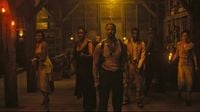Marvel Studios’ much-anticipated Blade reboot, which was set to star Mahershala Ali, has officially been removed from Disney’s 2025 release schedule, leaving fans wondering about the film’s future. The project had been mired in development hell for years, but while the movie itself remains in limbo, an unexpected piece of its legacy has already reached audiences through another film: Ryan Coogler’s critically acclaimed Sinners.
Renowned Oscar-winning costume designer Ruth E Carter, celebrated for her groundbreaking work on Black Panther, had meticulously prepared a full wardrobe of period-appropriate clothing for the Blade reboot before production was scrapped. These costumes, originally intended to bring to life the 1920s setting of Blade, found a new home in Sinners, a film that also explores a similar era, set in 1932 Mississippi.
According to Sev Ohanian, producer of Sinners and Ironheart, in an interview with ScreenCrush (via Variety), the transition of these costumes came about somewhat serendipitously. "Ruth Carter was working on the Blade movie that ended up not shooting," Ohanian explained. "At one point, that movie was going to deal with, and she's talked about this before, but at one point, that film was going to deal with the past around the same era as Sinners. She happened to have a warehouse full of period-appropriate clothes, and it was like, 'Yo, we got to shoot this movie like tomorrow.' And Marvel was generous enough and kind enough to let us basically purchase it at price."
This warehouse full of costumes provided a treasure trove for Sinners, allowing many background actors to don authentic period clothing originally designed for Blade. However, Carter did not simply recycle old designs; she created new, original looks specifically for the film’s lead characters, ensuring that Sinners maintained its unique visual identity despite borrowing elements from the abandoned MCU project.
Ryan Coogler’s Sinners stars Michael B. Jordan as twin brothers Smoke and Stack, who confront vampires in the deep South during the early 1930s. The film has been a remarkable success, grossing an impressive $365 million worldwide against a modest budget of around $95 million. This financial triumph underscores the continued viability of original films in the post-pandemic entertainment landscape, especially when budgets are managed carefully.
Critically, Sinners has been equally triumphant, boasting a 97% Tomatometer score on Rotten Tomatoes and a 96% Popcornmeter score, positioning it as a strong contender for next year’s Oscars. The film’s blend of horror, southern gothic atmosphere, and period detail has resonated deeply with audiences and critics alike, and the costumes—many of which owe their existence to the shelved Blade project—have been singled out for praise.
The connection between Sinners and the MCU does not end with costumes. Ryan Coogler, who directed Sinners, is also deeply involved with Marvel Studios, having directed the first two Black Panther films. He is expected to return to the MCU soon with Black Panther 3. Adding to the excitement, Denzel Washington recently confirmed his involvement in the sequel, a collaboration Coogler has long sought to realize.
Speaking on Carmelo Anthony's 7PM in Brooklyn podcast, Coogler shared his admiration for Washington: "There's no fiction out there. Denzel is family at this point ... I've been trying to work with him since day one. I think he's the greatest living actor, and in terms of what he means to our culture, forget about it. I've been talking to him about this to him for a long time." This revelation highlights the deep respect and ambition driving Coogler’s projects both within and outside the Marvel universe.
Marvel’s decision to shelve the Blade reboot has been a disappointment to many fans, especially given Mahershala Ali’s acclaimed talent and the promise of a fresh take on the vampire hunter’s story. The 1920s setting would have offered a unique historical backdrop, blending horror and period drama in a way that few superhero films attempt. However, the repurposing of the project’s costumes for Sinners demonstrates how creative resources can find new life, enriching other stories and connecting seemingly disparate projects.
It’s fascinating to consider how the abandoned Blade film’s legacy persists through Sinners. The costumes, painstakingly designed by Carter, provide a tangible link between the two projects, weaving Marvel’s unrealized vision into Coogler’s original narrative. This crossover of creative elements underscores the collaborative and often unpredictable nature of filmmaking, where ideas and assets sometimes migrate in unexpected directions.
While Blade’s future remains uncertain, Coogler’s return to the MCU with Black Panther 3 promises to keep fans engaged. The inclusion of Denzel Washington adds further prestige and anticipation to the sequel, suggesting that Coogler’s vision for the franchise will continue to evolve in exciting ways.
In the meantime, Sinners stands as a testament to originality and resourcefulness in cinema. It shows how a film can thrive by blending fresh storytelling with elements borrowed from other projects, especially when those elements are handled with care and creativity. The costumes, originally destined for a different story, have helped bring Sinners’ haunting world to vivid life, contributing to its critical and commercial success.
Ultimately, the tale of these costumes—from a long-delayed superhero film to a breakout horror hit—illustrates the unpredictable journeys behind the scenes in Hollywood. It’s a reminder that even when projects falter, their creative spirit can endure, shaping new stories and captivating audiences in unexpected ways.





